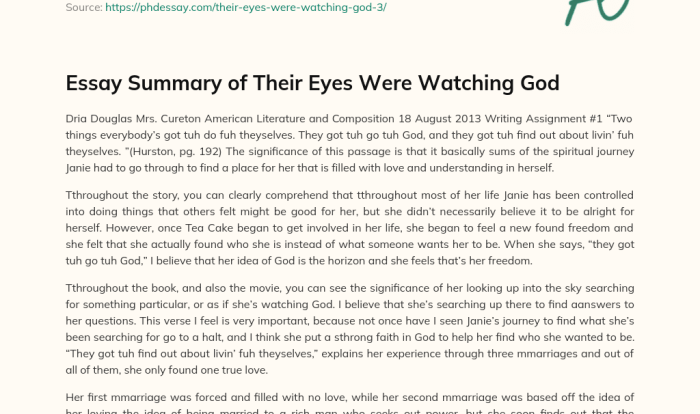To kill a mockingbird literary terms – Harper Lee’s seminal novel “To Kill a Mockingbird” is a masterpiece of American literature that has captivated readers for generations. Through its intricate symbolism, well-developed characters, and exploration of timeless themes, the novel offers a profound and enduring examination of the human condition.
This comprehensive analysis delves into the literary elements that contribute to the novel’s enduring legacy, including its rich symbolism, nuanced characterization, exploration of complex themes, and skillful use of narrative techniques.
Symbolism
Symbolism plays a crucial role in To Kill a Mockingbird, enriching the narrative with profound meanings and interpretations.
The Mockingbird
The mockingbird, a symbol of innocence and harmlessness, represents the vulnerable and innocent victims of prejudice and injustice in the novel. Mockingbirds are known for their beautiful songs, yet they are often targeted for their harmless nature. This symbolism highlights the tragic consequences of targeting the innocent, as seen in the unjust treatment of Tom Robinson.
Other Symbols
- The Radley House:A mysterious and enigmatic symbol of fear and prejudice, representing the unknown and the secrets hidden within society.
- The Oak Tree:A symbol of strength, resilience, and wisdom, representing the enduring spirit of the human soul amidst adversity.
- The Jim Crow Laws:Symbolized by the mockingbird’s inability to sing freely, these laws represent the oppressive and unjust system of racial segregation in the South.
Colors, To kill a mockingbird literary terms
- White:Purity, innocence, and vulnerability (e.g., Boo Radley)
- Black:Darkness, evil, and prejudice (e.g., Bob Ewell)
- Green:Growth, hope, and renewal (e.g., the mockingbird’s eggs)
Characterization
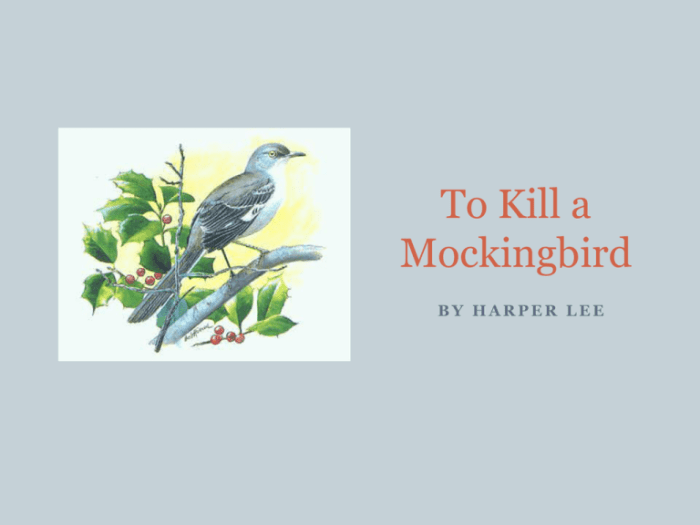
Main Characters
- Scout Finch:A precocious and tomboyish narrator who undergoes a profound moral journey, learning about the complexities of race, prejudice, and justice.
- Atticus Finch:A principled and compassionate lawyer who serves as a moral compass for the community, fighting for justice and equality.
- Tom Robinson:A black man falsely accused of raping a white woman, symbolizing the tragic consequences of prejudice and injustice.
- Boo Radley:A mysterious and misunderstood recluse who represents the fear of the unknown and the power of compassion.
Scout Finch as Narrator and Protagonist
As the narrator, Scout provides a unique perspective on the events of the novel, filtering them through the lens of her childhood innocence and developing moral awareness. Her growth as a character reflects the novel’s exploration of the complexities of human nature and the challenges of confronting prejudice.
Atticus Finch as Moral Compass
Atticus Finch serves as a moral beacon in the novel, representing the principles of justice, equality, and compassion. His unwavering commitment to defending Tom Robinson, despite the overwhelming odds, exemplifies his unwavering belief in the inherent dignity of all human beings.
Themes: To Kill A Mockingbird Literary Terms
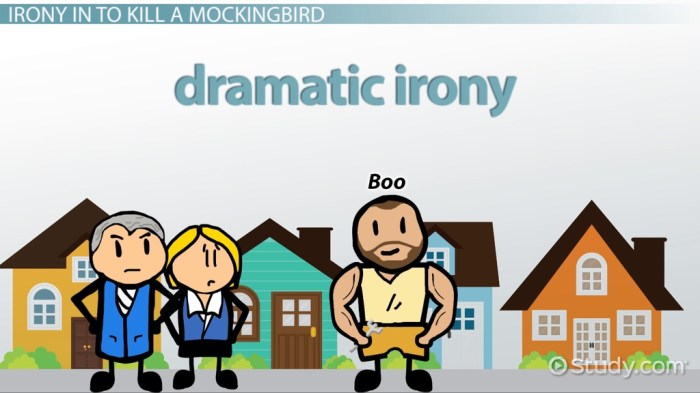
- Racism and Prejudice:The novel exposes the deep-seated racism and prejudice that permeate Southern society, exploring the devastating consequences of these social evils.
- Justice and Injustice:The novel raises questions about the nature of justice and the challenges of achieving it in a society divided by prejudice and inequality.
- Loss of Innocence:The novel depicts the loss of innocence as children confront the harsh realities of racism and injustice, forcing them to grapple with the complexities of the adult world.
- Empathy and Compassion:The novel emphasizes the importance of empathy and compassion, urging readers to understand the perspectives of others and to treat all human beings with dignity and respect.
Evidence from the Text
- Racism and Prejudice:Tom Robinson’s unjust trial and the lynching of innocent black men.
- Justice and Injustice:Atticus Finch’s unwavering defense of Tom Robinson, despite the overwhelming odds.
- Loss of Innocence:Scout’s gradual realization of the racism and prejudice that exist in her community.
- Empathy and Compassion:Scout’s growing understanding of Boo Radley and her eventual compassion for him.
Setting
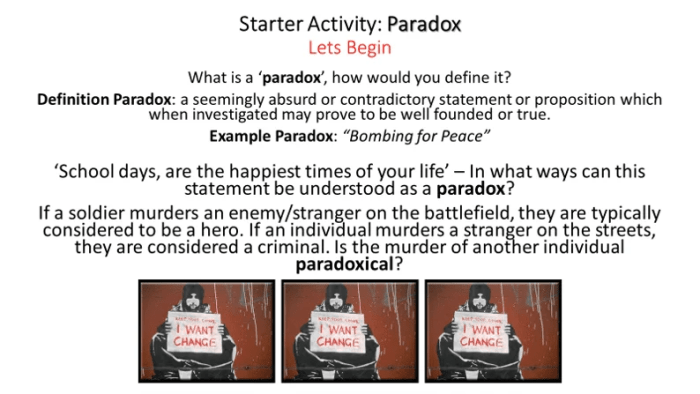
Maycomb, Alabama
The novel is set in the fictional town of Maycomb, Alabama, during the 1930s. Maycomb represents the rural South during the Jim Crow era, where racism and prejudice are deeply ingrained in the social fabric.
Time Period
The 1930s setting provides a historical context for the novel’s exploration of racism and prejudice. The Great Depression and the rise of fascism in Europe create a backdrop of social and economic turmoil that shapes the characters’ experiences.
Nature
Nature plays a significant role in the novel, symbolizing both the beauty and the harshness of life. The natural world provides a sanctuary for characters like Boo Radley and Scout, but it also harbors danger, as seen in the fire that destroys the Radley house.
Narrative Structure
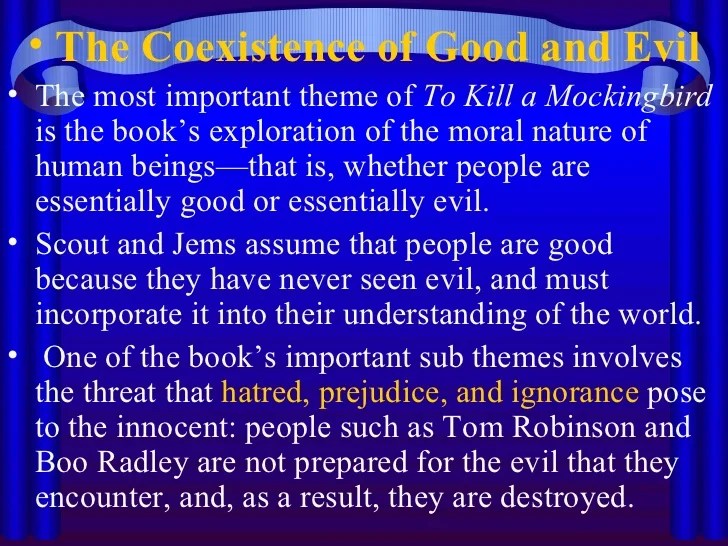
First-Person Narration
The novel is narrated from the first-person perspective of Scout Finch, providing an intimate and personal account of the events that unfold.
Flashbacks and Foreshadowing
The novel employs flashbacks and foreshadowing to create a sense of suspense and to reveal the complexities of the characters and their motivations. Flashbacks provide insights into the past, while foreshadowing hints at events that will occur later in the story.
Non-Linear Structure
The novel’s narrative structure is non-linear, as Scout recounts events out of chronological order. This structure allows for a more nuanced exploration of the themes and characters, as the reader is forced to piece together the events and their significance.
Literary Devices
Metaphors
- “Life is like a box of chocolates—you never know what you’re gonna get.”
- “The world’s a wheel. It’s always turning, and nobody’s on top forever.”
Similes
- “Atticus was like a rock in a restless sea.”
- “The Radley Place was like a haunted house, silent and still.”
Irony
- Dramatic Irony:The reader knows more than the characters, creating a sense of suspense and foreshadowing.
- Situational Irony:The outcome of a situation is the opposite of what is expected.
Impact on Themes and Characters
These literary devices enhance the novel’s themes and characterization by creating vivid imagery, emphasizing key ideas, and highlighting the complexities of the characters and their motivations.
Top FAQs
What is the significance of the mockingbird in the novel?
The mockingbird symbolizes innocence, vulnerability, and the destruction of beauty. Its death at the hands of Bob Ewell represents the loss of these qualities in the face of prejudice and hatred.
How does Scout Finch’s perspective as a child narrator shape the novel?
Scout’s perspective provides a unique and innocent lens through which the complex events of the novel are filtered. Her childlike observations highlight the hypocrisy and injustice of the adult world, while her growth and understanding throughout the story add depth and complexity to the narrative.
What are the major themes explored in “To Kill a Mockingbird”?
The novel explores themes of racism, prejudice, justice, innocence, and the loss of innocence. It examines the destructive power of prejudice and the importance of standing up for what is right, even in the face of adversity.
